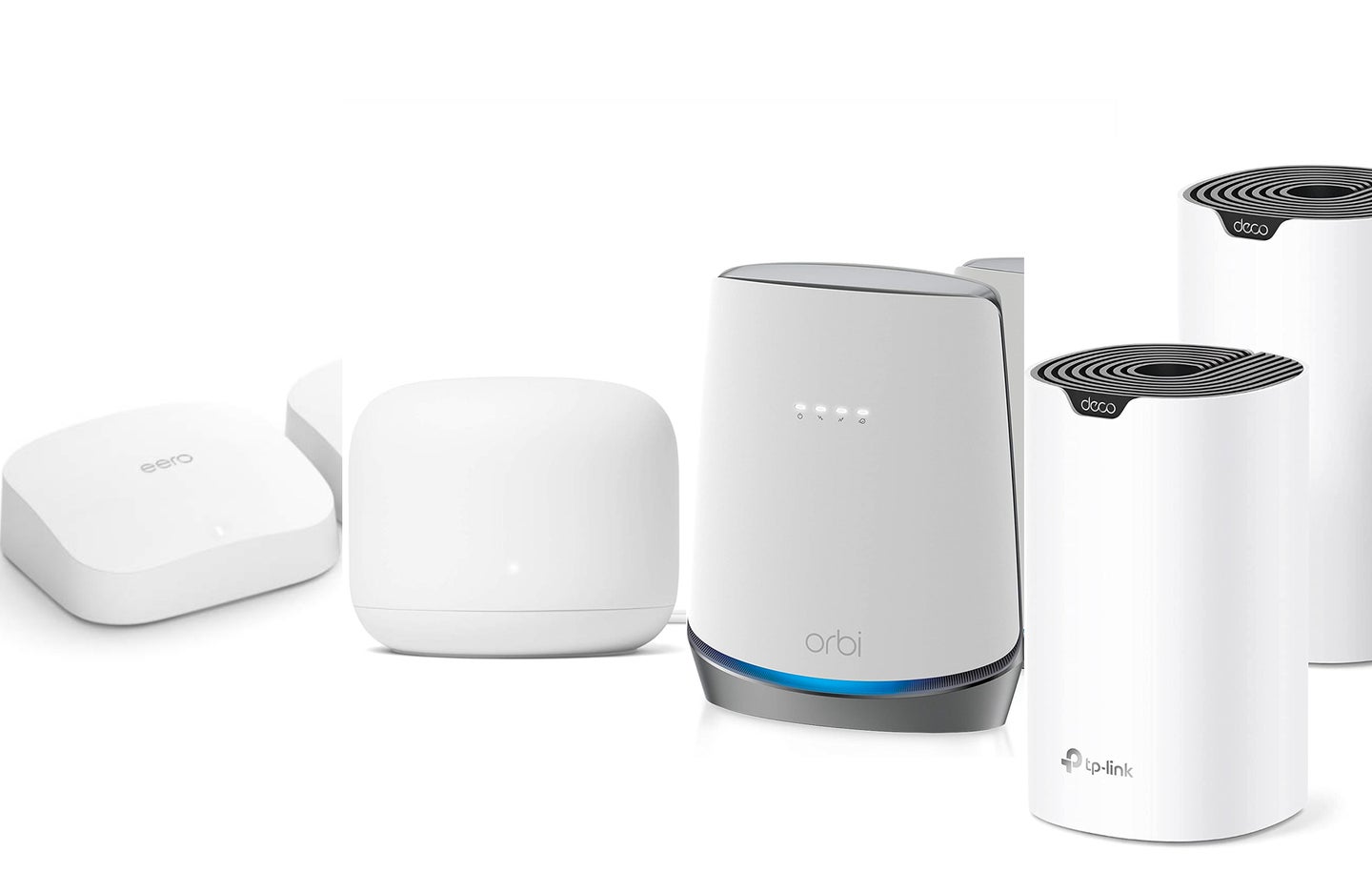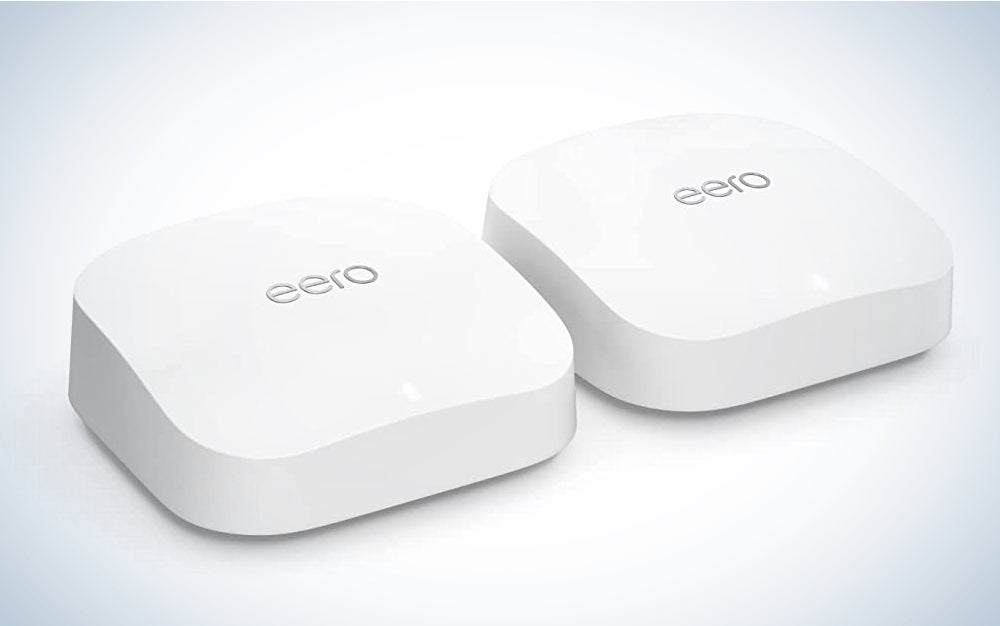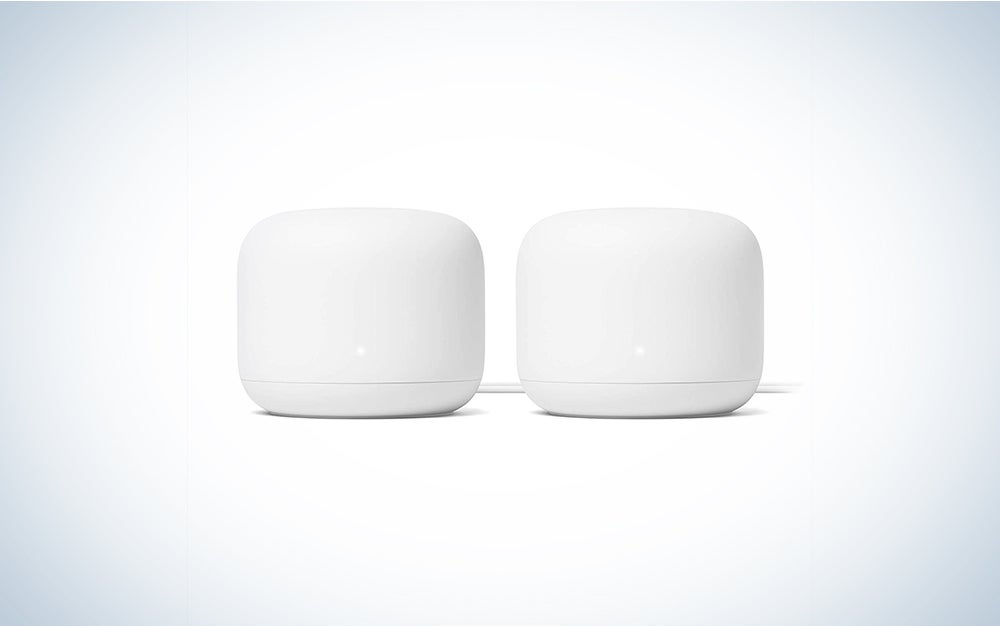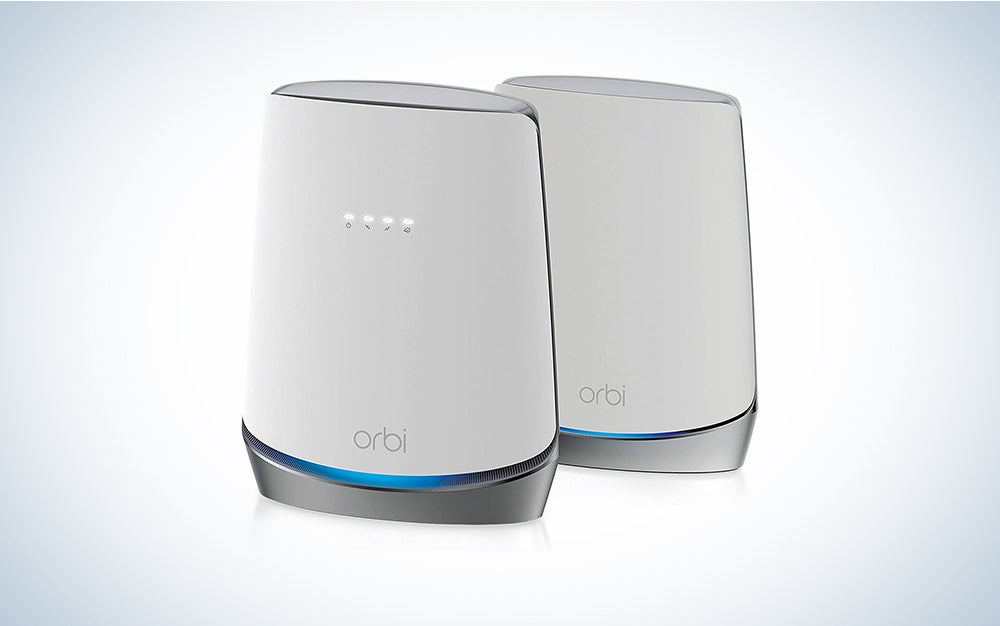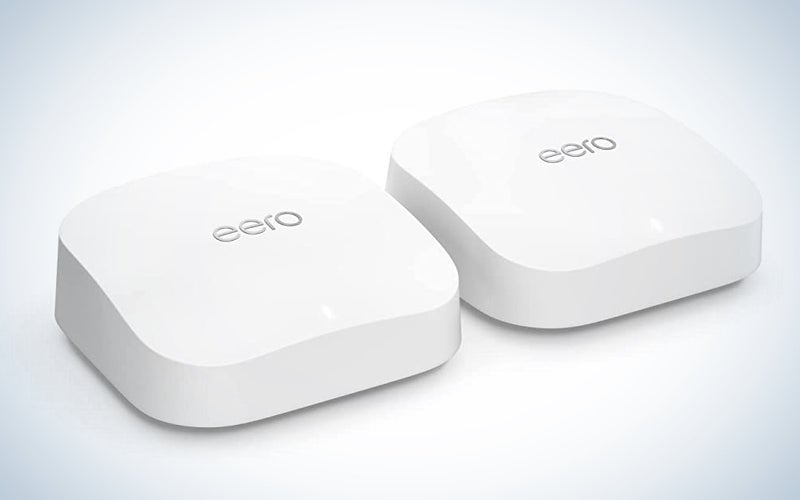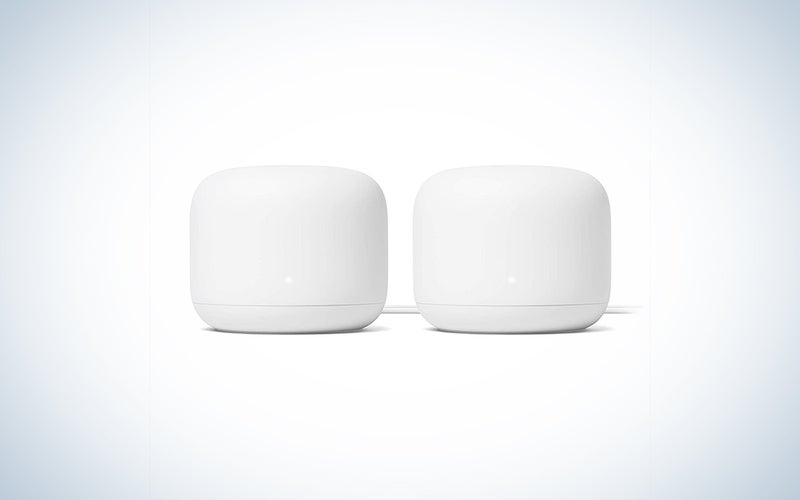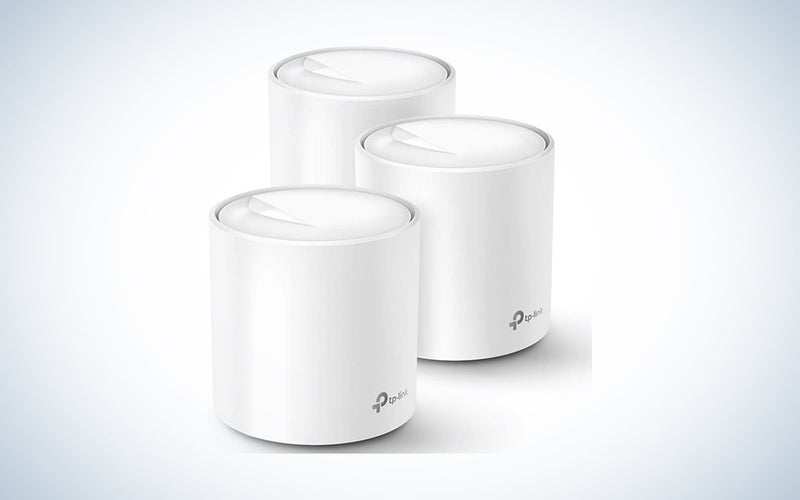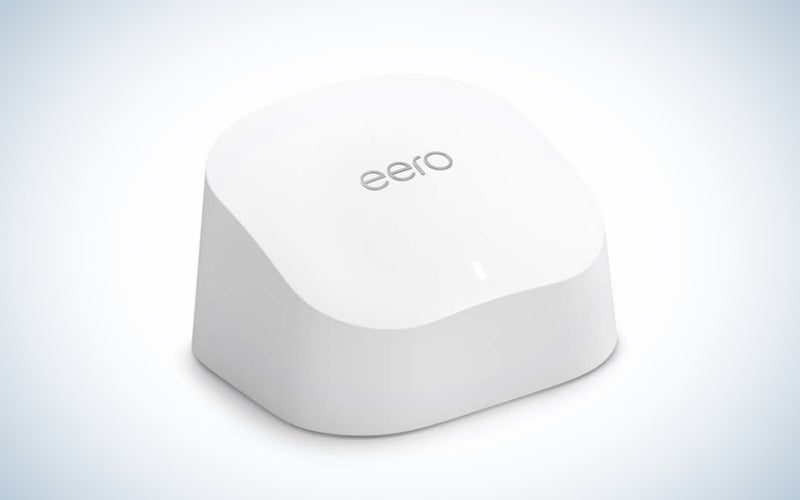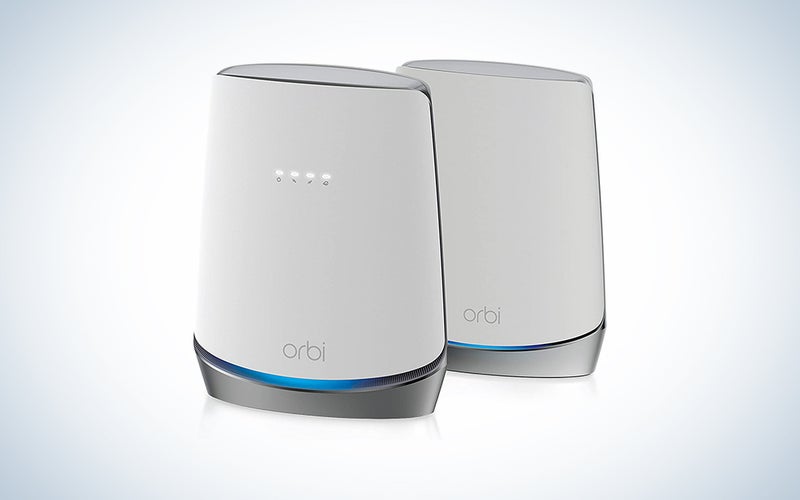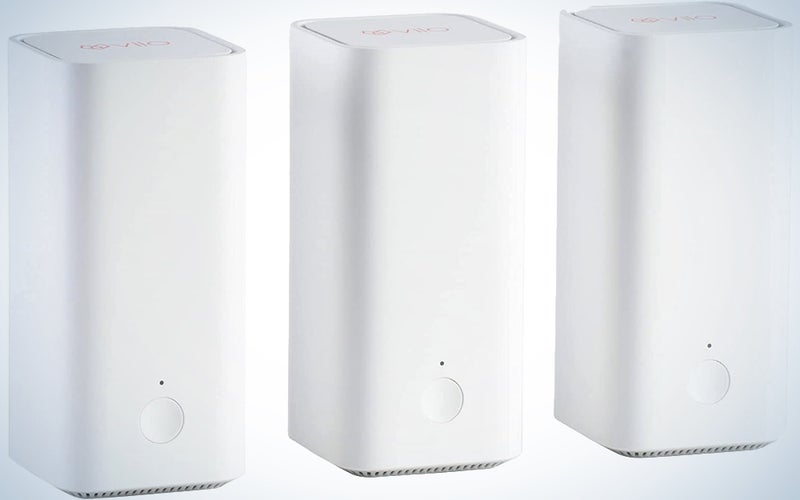We may earn revenue from the products available on this page and participate in affiliate programs. Learn more ›
Wi-Fi routers are legendarily annoying. They’re opaque, with hundreds of obscure settings and features that—unless you love inelegant, browser-based interfaces—are often difficult even to access, let alone tweak. They go down for no reason, and if they’re not completely offline, the signal is flummoxed by such ordinary problems as a wall between your device and the hotspot. The best mesh Wi-Fi systems, however, are one of the greatest innovations to come to home internet in years.
Just another plastic puck with some blinking lights, a mesh Wi-Fi station may not look that different from the traditionally cumbersome models. It’s so unassuming you may wonder if it’s worth the extra investment. You’ll quickly find, however, that mesh Wi-Fi can solve many of the most common problems. Using multiple nodes, wireless mesh networks let you space access points throughout your house (and yard, if you like), but they don’t act independently. Your devices will switch from station to station seamlessly without the need to save and manually select multiple network names and passwords. All devices can be configured through cleanly designed smartphone apps.
Another benefit to using mesh Wi-Fi is the ease of adding another router to your system after it’s set up. This adaptability allows you to use the same mesh Wi-Fi system if you move to a larger house, realize that your home still has degraded speeds or dead zones, or you’d like your network to cover the outside of your place. Many of the networking companies you’re familiar with have shifted their focus to mesh Wi-Fi systems—though there’s still a place for single-point routers, as we’ll explain in more detail in the FAQ section of this story. If your network needs have grown lately, a set of the best mesh Wi-Fi routers will help you keep up with those changes.
- Best overall: eero Pro 6e
- Best for homes: Google Nest Wi-Fi
- Best Wi-Fi 6 mesh router: TP-Link Deco 6
- Best mesh Wi-Fi extender: Amazon eero mesh router
- Best for speed: Netgear Orbi Wi-Fi 6
- Best budget: TP-Link Deco, Version S4
How we picked the best mesh Wi-Fi Routers
For this story, we surveyed the top brands and models of mesh Wi-Fi routers on the market. While you can’t truly test a mesh Wi-Fi system until you’ve lived with it for an extended period, we consulted tons of online research, editorial reviews, and hands-on experience to choose models that best fit people’s homes and lifestyles.
The best mesh Wi-Fi: Reviews & Recommendations
The best mesh Wi-Fi routers can cover your home with fast wireless internet regardless of size, the composition of its walls, or the number of devices you have connected. Routers are a gadget that shouldn’t be replaced very often—think seven to 10 years, so we’ve stuck with companies with a proven track record of providing continuous software and security updates over time. You shouldn’t have to think about troubleshooting very often either because finding ways to fix your home internet without the internet is tedious, so ease of use is another factor we strongly considered. The mesh Wi-Fi landscape changes regularly, and new technology constantly drops. We’re just getting into the world of Wi-Fi 6/6E, and Wi-Fi 7 is coming quickly on its heels. For now, though, you can feel comfortable trusting these models for their proven performance over time (just don’t forget to immediately address your security settings).
Best overall: eero Pro 6e
Amazon
Why it made the cut: This tried-and-true system covers large swaths of area with fast connections and lots of bandwidth.
Specs
- Coverage: Up to 4,000 square feet
- Speed: Up to 2.3 Gbps
- Tri-band
Pros
- Supports Wi-Fi 6E
- Powerful signal
- Fast data
Cons
- Pricy
Eero was the company that popularized mesh Wi-Fi routers and made them approachable and accessible to the average consumer. The company has since refined and expanded its line to include mesh Wi-Fi systems that cost as little as $139. But, if you want the best of the best, you’ll have to pony up for its Pre 6E mesh Wi-Fi system, which hits the sweet spot between incredibly proficient performance, ease of use, and price.
We’ve had the chance to test several mesh Wi-Fi systems, but Eero’s is the easiest to set up and manage. If you’re completely new to mesh Wi-Fi routers, the onboarding process is streamlined, so you’ll be up and running within a half hour. Most of your setup time will be devoted to creating an account and figuring out the best place to put the system’s second router for maximum coverage. If you’re upgrading from a previous Eero Wi-Fi system, you’ll be able to add the routers to your existing network before taking the old ones offline.
Eero’s Pro 6E mesh Wi-Fi System supports the Wi-Fi 6E standard, currently the most up-to-date Wi-Fi protocol available. Wi-Fi 6E allows routers to achieve wireless data transfer speeds up to 1.3Gbps. Nobody needs that much bandwidth (few people even have an internet plan that supports Gigabit speeds), but it does help with network congestion. If multiple people are trying to download large files at once, the router can provide a solid, fast connection to both rather than severely throttling one of the requests until the other is finished. The routers in this mesh Wi-Fi system also benefit from the fact that they have three bands, which means they send out a signal at three frequencies instead of two. Devices will automatically connect to the one that offers the best performance based on their Wi-Fi chip, which leaves more space for other ones. Thankfully, all of this networking wizardry happens behind the scenes, so you don’t end up with multiple networks: Network Name and Network Name 5GHz and the like.
Our experience with Eero’s routers goes back to the very first generation released over half a decade ago, but somehow its networking gear continues to impress. In our tests, Eero’s Pro 6E routers created a fast, rock-solid connection that maxed out our internet connection and provided enough coverage for a three-floor condo. While our experience was universally positive, we noticed gadgets that support Wi-Fi 6 (the latest iPhones, for instance) could take full advantage of the speeds on offer. Eero has had to make its routers larger to accommodate additional networking hardware, but they’re still the best-looking option. Aesthetics don’t matter nearly as much as performance, but Wi-Fi routers are among the few gadgets that need to be out in the open to work properly. Anyone who comes into your home likely won’t notice the routers, which is sort of the point.
Eero’s Pro 6E mesh Wi-Fi routers are the best choice to create a fast, far-reaching network that can handle dozens of connections without skipping a beat. The company’s easy-to-use app and focus on aesthetics are also welcome and complement the routers’ performance wonderfully.
Best for homes: Google Nest Wi-Fi
Amazon
Why it made the cut: A reliable connection with tight ties to Google Home makes this an attractive and easily expandable solution.
Specs
- Coverage: 4,400 square feet
- Speed: Up to 1 Gbps
- Dual-band
Pros
- Easy setup
- Ties nicely into Google Home
- Small and unobtrusive
Cons
- No Wi-Fi 6 in this model
Google’s Wi-Fi system, which was recently brought under the “Nest” umbrella, is one of the fastest home mesh Wi-Fi systems on the market and one of the most handsome. It’s also incredibly easy to use: just pop open the app, and you’ll be able to do simple tasks without any trouble, whether creating a guest network, sharing your password with a friend, or instituting parental controls. It’s on the pricey side—but lets you pick an initial, appropriately priced pack of one, two, or three units—and it’s backward compatible with previous versions of Google Wi-Fi, which can help you save a little money on satellite beacons you already have or come across on closeout sale.
Best Wi-Fi 6 mesh router: TP-Link Deco 6
Amazon
Why we picked it: Wi-Fi 6 routers are starting to emerge, and this advanced system is ahead of the curve regarding features and compatibility.
Specs
- Coverage: 5,800 square feet
- Speed: 1.8 Gbps
- Tri-band
Pros
- Wi-Fi 6 support
- Affordable
- Supports up to 150 connected devices
Cons
- Not the prettiest design
Do you need a Wi-Fi 6 mesh router right now? Maybe. But routers aren’t something we replace that often, so you might want to consider picking one that’ll be compatible with Wi-Fi 6 when it comes. The TP-Link Deco 6 provides super-fast speeds to up to 150 devices, which is one of the hallmarks of the next-generation Wi-Fi 6 standard. It comes with three stations and, at this price, is actually cheaper than some mesh systems without Wi-FI 6. Reviewers note that the included ethernet cable is a bit short and that the app isn’t quite as easy to use as others, but speed and ease of setup are both said to be excellent. In addition, it’s compatible with Alexa if you’re invested in Amazon’s smart home ecosystem.
Best mesh Wi-Fi extender: eero 6 Wi-Fi Extender
Amazon
Why it made the cut: This is an easy, relatively cheap way to get more internet in remote areas of your home.
Specs
- Coverage: 1,500 square feet
- Speed: 500 Mbps
- Dual-band
Pros
- Small
- Fast
- Lots of range for a small box
Cons
- Requires compatible system
One of the best things about mesh network systems is that if you ever move or find that your current setup doesn’t cover the entire area you need, you can always just buy an extra station. That said, you need to buy an additional router made by the same company as your mesh Wi-Fi system, there’s no option to mix and match. Suppose you only need your network to reach just a little further. In that case, you may get away with using a basic Wi-Fi range extender or booster, which is interoperable with any mesh Wi-Fi system but isn’t as powerful as a router and will require you to use two apps to manage your network.
Because we’ve chosen Eero’s Pro 6e as the top mesh Wi-Fi system, we’ve elected to show you how to extend an Eero network using the company’s Wi-Fi 6 Extender. This standalone station works with any existing eero system, adds 1,500 square feet of coverage, and gets continual firmware updates to ensure it’s always securely patched and up to date. The simple accessory is the easiest way to stretch your Eero network. If you have mesh Wi-Fi routers from a different company, search for a compatible extender from the same brand.
Best for speed: Netgear Orbi Wi-Fi 6
Amazon
Why we picked it: If you’re looking for super-fast speeds, this system has the bandwidth to spare that it can share across many devices.
Specs
- Coverage: 5,000 square feet
- Speed: 2.5 Gbps
- Tri-band
Pros
- Fast connection
- Good security
- Attractive device
Cons
- Software can be buggy
Far be it from us to discourage you from finding the absolute fastest Wi-Fi 6 mesh router system on the market. And the Netgear Orbi Wi-Fi 6 is certainly that. It supports the newest Wi-Fi standard, provides up to 2.5Gbps service, and supports over 100 different gadgets simultaneously. It even gives you plenty of Ethernet ports on the satellite stations if you want to hardwire (well, part-hardwire, since there’s still wireless involved) any gaming systems, Smart TVs, etc. If you have a house full of demanding Full HD/4K devices, you want to ensure no one will have to buffer or suffer. The biggest downside? Price. This baby isn’t cheap, but you get a lot for your money, and reviews are glowing.
Best budget: Vilo Mesh Wi-Fi System
Vilo
Why it made the cut: It’s not the bleeding edge technology, but not everyone needs that. You get fast, reliable connectivity in an attractive package without much hassle.
Specs
- Coverage: 4,500 square feet
- Speed: 867Mbps
- Dual-band
Pros
- Affordable
- Supports up to 120 devices
- Built-in parental controls
Cons
- No Wi-Fi 6
If you want a whole-home Wi-Fi solution but don’t want to spend a lot of money, Vilo’s Mesh Wi-Fi System is the obvious choice. It may cost $100, but Vilo managed to cut down the price of its networking gear without compromising many features. This mesh Wi-Fi system’s marquee feature is its impressive 4,500-square-foot range, which is on par with what you’d expect from more expensive hardware. Granted, some higher-end systems can achieve that coverage area with two routers instead of three, but that’s not a huge deal.
Setting up and using Vilo’s Wi-Fi System is managed using an app, which also gives you granular control over which sites certain devices can visit. This per-device version of parental controls can be very helpful in homes with adults and children. Vilo says its routers can be connected to 120 devices simultaneously, which is impressive and makes them a solid choice if you’ve built up a sizable smart home, or plan to in the near future.
While Vilo didn’t have to cut any big corners to achieve its price point, something did have to give. The routers don’t support Wi-Fi 6, which would have been nice but isn’t a deal breaker. Additionally, the mesh Wi-Fi routers only have two bands instead of three. The reduction in speed from these two technical decisions isn’t gigantic but may be noticeable when your home network is taxed. Under normal circumstances—one person streaming a show on one TV while another person plays video games on a console and a third person streams music, for example, there shouldn’t be an issue. If you’ve held off on adopting a mesh Wi-Fi system because of cost, Vilo’s routers give you no excuse.
Things to consider when buying the best mesh Wi-Fi routers
Wi-Fi version: Wi-Fi routers used to be categorized by a series of letters (N, AC, AX), but that’s been simplified to a number, which makes it easier to determine what the latest standard is. The most up-to-date Wi-Fi version on the market is 6E. Wi-Fi is a universal wireless standard, which means devices don’t need to have a Wi-Fi 6E-compatible chip inside to connect to a cutting-edge router.
Range: One of the big advantages of using a set of mesh Wi-Fi routers instead of a single-point router is increased range. You’ll want to get a rough measurement of your home (including the porch and backyard, if applicable) to determine which mesh Wi-Fi router system will work best for you. Our general rule is to have one Wi-Fi router on every floor of your home to have the best chance of even coverage.
Speed: A mesh Wi-Fi router’s speed is typically calculated in Mbps (Megabits per second), though Wi-Fi 6E systems operate in Gbps (Gigabits per second). This factor matters less than you may think because the Internet speed you actually get will be determined by the plan you’ve signed up for through your ISP (Internet Service Provider).
Bands: Most mesh Wi-Fi routers have two bands, which allow them to send a signal at two frequencies: 2.4GHz and 5GHz. The 5GHz frequency band offers higher speeds and will be less susceptible to interference from legacy wireless electronics like landline telephones. That said, some smart home accessories can only connect to the internet using a 2.4GHz frequency.
FAQs
Q: How much should a mesh Wi-Fi system cost?
This depends on your needs, but you shouldn’t have to spend more than $150 to get a solid mesh Wi-Fi system. If you want the latest and greatest gear—this may make more sense if you live with many people—setting one up may cost you closer to $350.
Q: Does mesh Wi-Fi replace my router?
Yep, mesh Wi-Fi systems replace a standard, standalone router. Sometimes, your internet service provider will give you a modem with a router built-in, and you’ll have to ask them how to disable it so you can plug in a mesh Wi-Fi router, but that’s true of any router.
Q: Is mesh Wi-Fi better for gaming?
Mesh Wi-Fi is better for gaming than a standard wireless router, that’s for sure. Often, your gaming console or PC isn’t right next to a standalone router, and mesh Wi-Fi ensures you won’t have a weak signal or drops in your gaming room. If you’re really serious about multiplayer gaming, however, you’ll probably want to hardwire—plug your gaming device directly into your router with an Ethernet cable. You can do that just as well with a mesh Wi-Fi system.
Q: Will a mesh Wi-Fi network improve speed?
A mesh Wi-Fi network can improve speed, but the answer is a little more complex. If you opt for one of the higher-end mesh Wi-Fi systems—such as the Nest, Eero, or Orbi Wi-Fi 6—those will give you top-of-the-line speeds. More budget-friendly mesh systems will give you speeds comparable to a modestly priced regular router. But the difference is that regular routers only give you their best speeds when you’re next to them. Move further away, and you’ll get reduced speeds, maybe even dropped signals. Mesh Wi-Fi systems won’t do that; you’ll get the top speeds your unit is capable of no matter where you are.
Q: How is a mesh Wi-Fi router different from a Wi-Fi range extender?
A mesh Wi-Fi router is a lot more powerful than a range extender, which means it’ll extend your network further and offer faster speeds. Additionally, you can control a mesh Wi-Fi router system using a single app, which makes it easier to setup and troubleshoot if something goes wrong.
Q: How do mesh Wi-Fi systems work?
A mesh Wi-Fi system consists of multiple routers that connect to create a larger, more consistent network in your home. One of the routers must be connected to your cable modem using an Ethernet cable, but the others can be plugged in anywhere there’s an outlet. Once all the routers are installed, they’ll automatically find one another, and your device will connect to whichever one is closest to you.
Q: Is a mesh Wi-Fi system better than a single-point router?
If you have a large space, you should only consider setting up a mesh Wi-Fi system because it gives you the best chance of having a fast Internet connection throughout your entire place without stringing wires through your walls. A single router isn’t capable of reaching that far, which leaves you with dead zones.
Q: Do Wi-Fi mesh systems support Wi-Fi 6?
Some, but not all, Wi-Fi mesh systems support Wi-Fi 6. That feature is coming to more systems every year and has nearly become an industry standard.
Q: What are the disadvantages of a mesh network?
Mesh Wi-Fi systems are typically more expensive than a single point router and require you to keep multiple routers in different rooms of your home, which can be difficult or annoying if they’re large or oddly shaped.
Q: Do you lose speed with mesh Wi-Fi?
No, the main benefit of using a mesh Wi-Fi system is having consistent speeds over a large area.
The final word on the best mesh Wi-Fi
- Best overall: eero Pro 6e
- Best for homes: Google Nest Wi-Fi
- Best Wi-Fi 6 mesh router: TP-Link Deco 6
- Best mesh Wi-Fi extender: Amazon eero mesh router
- Best for speed: Netgear Orbi Wi-Fi 6
- Best budget: TP-Link Deco, Version S4
Look, we get it: It’s hard to get excited about a router. But the best mesh Wi-Fi systems are a way to get the absolute most out of your home network—a way to think about your internet connection as little as possible and have it just work. And that’s what we want out of our internet, right?
Why trust us
Popular Science started writing about technology more than 150 years ago. There was no such thing as “gadget writing” when we published our first issue in 1872, but if there was, our mission to demystify the world of innovation for everyday readers means we would have been all over it. Here in the present, PopSci is fully committed to helping readers navigate the increasingly intimidating array of devices on the market right now.
Our writers and editors have combined decades of experience covering and reviewing consumer electronics. We each have our own obsessive specialties—from high-end audio to video games to cameras and beyond—but when we’re reviewing devices outside of our immediate wheelhouses, we do our best to seek out trustworthy voices and opinions to help guide people to the very best recommendations. We know we don’t know everything, but we’re excited to live through the analysis paralysis that internet shopping can spur so readers don’t have to.
